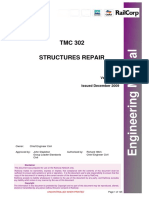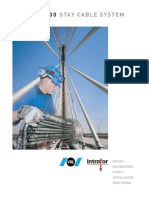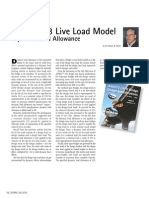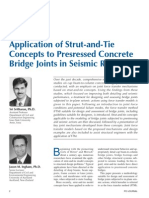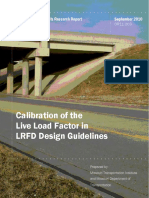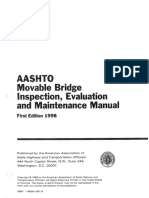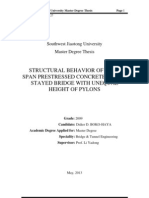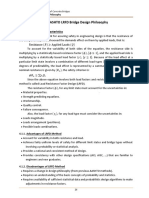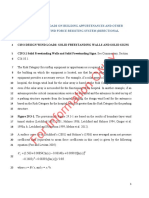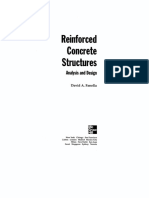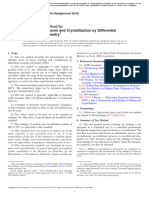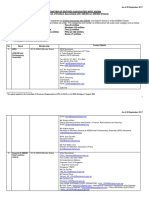AASHTO Publications Catalog: Bridges and Structures
AASHTO Publications Catalog: Bridges and Structures
Uploaded by
Thamilppavai P.MCopyright:
Available Formats
AASHTO Publications Catalog: Bridges and Structures
AASHTO Publications Catalog: Bridges and Structures
Uploaded by
Thamilppavai P.MOriginal Title
Copyright
Available Formats
Share this document
Did you find this document useful?
Is this content inappropriate?
Copyright:
Available Formats
AASHTO Publications Catalog: Bridges and Structures
AASHTO Publications Catalog: Bridges and Structures
Uploaded by
Thamilppavai P.MCopyright:
Available Formats
AASHTO Publications Catalog
BRIDGES AND STRUCTURES
AASHTO
CONTENTS
Publications
Catalog BRIDGE DESIGN............................................................ 3
Bridges and
SPECIALTY BRIDGE DESIGN................................... 4
BRIDGE CONSTRUCTION.......................................... 9
Structures STRUCTURAL INSPECTION
AND EVALUATION...................................................... 11
AASHTO publishes numerous technical
standards and guidelines through the work of
the association's technical committees, whose OTHER STRUCTURAL DESIGN...............................13
members are comprised of representatives from
the state departments of transportationÑthe
AASHTOÑNSBA STEEL
nation's transportation experts. AASHTO standards
BRIDGE COLLABORATION..................................... 14
and guidelines are utilized by transportation
agencies across the nation and worldwide.
STANDARD SPECIFICATIONS............................... 15
This Bridges & Structures Publications Catalog
details the broad spectrum of AASHTO technical
standards and guidelines related to the design,
construction, inspection, evaluation, and
maintenance of bridges and related structures.
ORDER AASHTO PUBLICATIONS
To order copies of any of the publications in this catalog, visit the AASHTO Store online at
https://store.transportation.org, and search by the publication's item code, which is listed below each
publication's title.
JOIN THE AASHTO PUBLICATIONS MAILING LIST!
Stay up to date with AASHTO Publications news by joining the AASHTO Publications Mailing List.
As a subscriber, you'll receive the latest information and news about our publications, including—
y Our monthly publications newsletter, the AASHTO Publications Update;
y Notification about new publication releases and updates; and
y Periodic alerts about special publication discounts and promotions!
Click here to join the AASHTO Publications Mailing List.
2 AASHTO BRIDGES AND STRUCTURES CATALOG
BRIDGE DESIGN
y
E N TI A
LRFD BRIDGE DESIGN SPECIFICATIONS, SS
E
VOLUME 1
L
9TH EDITION AASHTO
Item Code: LRFDBDS-9
LI
BRARY
The AASHTO LRFD Bridge Design Specifications are intended for use in
the design, evaluation, and rehabilitation of bridges. The specifications
employ the Load and Resistance Factor Design (LRFD) methodology,
using factors developed from current statistical knowledge of loads
and structural performance. This new 9th edition includes revisions to
almost all sections of the specifications. It supersedes the 8th Edition, LRFD BRIDGE
DESIGN
published in 2017. 2020. 1,920 pp.
SPECIFICATIONS
PDF DOWNLOAD Code: LRFD-9-UL | List Price: $520 |
Member Price: $385
LOOSELEAF Code: LRFD-9 | List Price: $650 | Member Price: $481
LOOSELEAF & PDF COMBO Code: LRFD-9-PUL | List Price: $910 |
Member Price: $674
5-USER PDF DOWNLOAD Code 5 Uesers: LRFD-9-IP5 | 9th Edition | 2020
978-1-56051-738-2 | LRFDBDS-9
List Price: $2,207 | Member Price: $1,635
10-USER PDF DOWNLOAD Code: LRFD-9-IP10 | List Price: $4,127 | Member Price: $3,057
25-User PDF Download Code: LRFD-9-IP25 | List Price: $9,112 | Member Price: $6,750
LRFD GUIDE SPECIFICATIONS FOR ACCELERATED BRIDGE CONSTRUCTION,
1ST EDITION
Item Code: ABC-1-UL
These guide specifications compile the growing body of recommended design and construction
specifications for prefabricated bridge elements and systems for accelerated bridge construction, with
a focus on constructability and durability. 2018. 225 pp.
PDF DOWNLOAD Code: ABC-1-UL | List Price: $270 | Member Price: $200
GUIDE DESIGN SPECIFICATIONS FOR BRIDGE TEMPORARY WORKS,
2ND EDITION, WITH 2020 INTERIM REVISIONS
Item Code: GSBTW-2-UL
These design specifications reflect the current state of the practice for the design and construction of
falsework, formwork, and temporary retaining structures. This 2017 2nd edition supersedes the 2008
1st edition. 2017. 113 pp.
PDF DOWNLOAD Code: GSBTW-2-UL | List Price: $162 | Member Price: $100
Interim Revisions Available Separately
ORDER PUBLICATIONS | Online: https://store.transportation.org | Phone: 800-231-3475 3
GUIDE SPECIFICATIONS FOR WIND LOADS ON BRIDGES DURING
CONSTRUCTION, 1ST EDITION
Item Code: GSWLB-1-UL
These guide specifications establish minimum requirements for wind loads on bridges during
construction before a deck is placed. The wind loads determined using these specifications are to be
used for checking bridge girders, temporary and permanent bracing, and the permanent substructure
during the erection of the girders and up to the time of placement of the deck. All other aspects of the
design are to be performed in accordance to the AASHTO LRFD Bridge Design Specifications or as
specified as appropriate by the bridge owner. 2017. 26 pp.
PDF DOWNLOAD Code: GSWLB-1-UL | List Price: $49 | Member Price: $36
BRIDGE SECURITY GUIDELINES, 1ST EDITION
Item Code: BSG-1-UL
These guidelines offer guidance on bridge design for extreme events induced by man. They include
information on the response of concrete bridge columns subjected to blast loads, and blast-resistant design
detailing guidelines and analytical models of blast load distribution. The guidelines should be considered in
situations where resisting blast loads is deemed warranted by the owner or designer. 2011. 60 pp.
PDF DOWNLOAD Code: BSG-1-UL | List Price: $27 | Member Price: $20
SPECIALTY BRIDGE DESIGN
AASHTO LRFD MOVABLE HIGHWAY BRIDGE DESIGN SPECIFICATIONS, 2ND
EDITION, WITH 2008, 2010, 2011, 2012, 2014, AND 2015 INTERIM REVISIONS
Item Code: LRFDMOV-2-M
These specifications address the design of movable highway bridges, including bascule span, swing
span, and vertical lift bridges. They include information on the design of bridge spans, mechanical
systems, electrical systems, and bridge protection systems, as well as information on seismic analysis
and vessel impact analysis. This 2007 2nd edition supersedes the 2000 1st edition. 2007. 336 pp.
PDF DOWNLOAD Code: LRFDMOV-2-M-UL | List Price: $236 | Member Price: $175
LOOSELEAF Code: LRFDMOV-2-M | List Price: $295 | Member Price: $219
LOOSELEAF & PDF COMBO Code: LRFDMOV-2-M-PUL | List Price: $413 | Member Price: $306
Interim Revisions Available Separately
GUIDE FOR DESIGN AND CONSTRUCTION OF NEAR-SURFACE MOUNTED
TITANIUM ALLOY BARS FOR STRENGTHENING CONCRETE STRUCTURES,
1ST EDITION
Item Code: NSMT-1
This guide provides design and construction recommendations for strengthening existing reinforced
concrete structures with titanium alloy bars (TiABs), using the near-surface mounted (NSM)
construction method. The overall approach and organization of the guide are based on those presented
in ACI 440.2R (ACI, 2017). Design recommendations provided for shear and flexural strengthening are
based on and adapted from the AASHTO LRFD Bridge Design Specifications. The recommendations are
supported by experimental and analytical research, as well as field experiences that have demonstrated
the application of TiABs for strengthening full-scale specimens typical of bridge girders. The available
experimental evidence includes the influences of combined high-cycle fatigue and environmental
durability on the structural performance of NSM-TiAB strengthened girders. 2020. 50 pp.
PDF DOWNLOAD Code: NSMT-1-UL | List Price: $54 | Member Price: $40
4 AASHTO BRIDGES AND STRUCTURES CATALOG
HISTORIC BRIDGE PRESERVATION GUIDE, 1ST EDITION
Item Code: HBP-1
O M ING
This guide is a reference for the preservation and rehabilitation of both fixed and movable historic
C
N!
SOO
highway bridges. It aims to familiarize engineers with the unique and diverse skills needed for
successful historic bridge preservation and rehabilitation projects.
GUIDE FOR BRIDGE PRESERVATION ACTIONS, 1ST EDITION
Item Code: BPA-1
This guide is intended to offer guidance on selecting specific cost effective preservation and
O M ING
C
maintenance actions and treatments for agencies wishing to extend service life and estimate needed
O O N!
budgets to optimize performance of bridge inventories. It can be used to help preserve bridges
and extend their service life by selecting cost effective actions and treatments for various bridge S
elements based on exposure.
GUIDE SPECIFICATION FOR SERVICE LIFE DESIGN OF HIGHWAY BRIDGES,
1ST EDITION
Item Code: HBSLD-1
O M ING
C
N!
SOO
This guide specification is intended to offer design recommendations for agencies wishing to
implement service life design principles and detailing recommendations. It was developed to
incorporate quantitative approaches, along with proven deemed-to-satisfy provisions, into a
single comprehensive design document for implementation on a national level. It also establishes
a framework for service life design, while providing opportunities for refinement and expansion,
especially as new models capable of simulating deterioration mechanisms become available.
AASHTO GUIDE SPECIFICATIONS FOR LRFD SEISMIC BRIDGE DESIGN,
2ND EDITION, WITH 2012, 2014, AND 2015 INTERIM REVISIONS
Item Code: LRFDSEIS-2-M
These guide specifications cover seismic design for typical bridge types and apply to non-critical and non-
essential bridges. They are approved as an alternative to the seismic provisions included in the AASHTO
LRFD Bridge Design Specifications, differing in the use of displacement-based design procedures, instead of
the traditional force-based R-Factor method. The specifications include detailed guidance on earthquake-
resistant elements and systems, global design strategies, demand modelling, capacity calculation, and
liquefaction effects. This 2011 2nd edition supersedes the 2009 1st edition. 2011. 331 pp.
PDF DOWNLOAD Code: LRFDSEIS-2-UL | List Price: $230 | Member Price: $170
LOOSELEAF Code: LRFDSEIS-2-M | List Price: $287 | Member Price: $213
LOOSELEAF & PDF COMBO Code: LRFDSEIS-2-PUL | List Price: $402 | Member Price: $298
Interim Revisions Available Separately
ORDER PUBLICATIONS | Online: https://store.transportation.org | Phone: 800-231-3475 5
GUIDE SPECIFICATIONS FOR SEISMIC ISOLATION DESIGN, 4TH EDITION
Item Code: GSID-4
These guide specifications address major changes in the state of the art of seismic isolation design
for highway bridges and reflect changes in the way seismic hazard is defined in the AASHTO LRFD
Bridge Design Specifications and the AASHTO Guide Specifications for LRFD Seismic Bridge Design.
The specifications include industry trends in the design and construction of isolators, and provisions in
the design specifications that impact the design and testing of isolation bearings. This 2014 4th edition
supersedes the 2010 3rd edition. 2014. 482 pp.
PDF DOWNLOAD Code: GSID-4-UL | List Price: $270 | Member Price: $200
LOOSELEAF Code: GSID-4 | List Price: $338 | Member Price: $250
LOOSELEAF & PDF COMBO Code: GSID-4-PUL | List Price: $473 | Member Price: $350
GUIDE SPECIFICATIONS FOR BRIDGES CARRYING LIGHT RAIL TRANSIT
LOADS, 1ST EDITION
Item Code: GSLR-1-UL
These guide specifications address the design of bridges subjected to light rail transit (LRT) loadings,
or both LRT and conventional highway traffic loadings. The guide specifications are largely dedicated
to LRT load cases and load effects, and the analysis of bridges subjected to LRT loadings. 2018. 32 pp.
PDF DOWNLOAD Code: GSLR-1-UL | List Price: $38 | Member Price: $28
LRFD GUIDE SPECIFICATIONS FOR THE DESIGN OF PEDESTRIAN BRIDGES,
2ND EDITION, WITH 2015 INTERIM REVISIONS
Item Code: GSDPB-2
These guide specifications address the design and construction of typical pedestrian bridges that are
designed to carry, primarily, pedestrians, bicyclists, equestrian riders, and light maintenance vehicles.
This 2009 2nd edition supersedes the 1997 1st edition. 2009. 36 pp.
PDF DOWNLOAD Code: GSDPB-2-UL | List Price: $41 | Member Price: $30
PAPERBACK Code: GSDPB-2 | List Price: $51 | Member Price: $38
LOOSELEAF & PDF COMBO Code: GSDPB-2-PUL List Price: $71 | Member Price: $53
Interim Revisions Available Separately
GUIDE SPECIFICATIONS FOR DESIGN OF FRP PEDESTRIAN BRIDGES,
1ST EDITION
Item Code: GSDFPB-1
These guide specifications apply to fiber-reinforced polymer (FRP) composite bridges intended to
carry, primarily, pedestrian and bicycle traffic. 2008. 20 pp.
PDF DOWNLOAD Code: GSDFPB-1-UL | List Price: $27 | Member Price: $20
LOOSELEAF Code: GSDFPB-1 | List Price: $34 | Member Price: $25
LOOSELEAF & PDF COMBO Code: GSDFPB-1-PUL | List Price: $47 | Member Price: $35
6 AASHTO BRIDGES AND STRUCTURES CATALOG
AASHTO LRFD BRIDGE DESIGN GUIDE SPECIFICATIONS FOR
GFRP-REINFORCED CONCRETE, 2ND EDITION
Item Code: GFRP-2-UL
These guide specifications offer a description of the unique material properties of glass fiber-
reinforced polymer (GFRP) composite materials, as well as provisions for the design and construction
of concrete bridge decks and railings reinforced with GFRP reinforcing bars. The specifications
include information on the advancements in material specifications; new knowledge and field
experiences beyond bridge decks and traffic railings; greater consistency with the AASHTO LRFD
Bridge Design Specifications, 8th Edition; consideration of flexural members, such as girders and bent
caps; consideration of substructure and foundation elements, along with compression members;
differentiation between the fatigue and creep limit states; and revised shear design methodology.
This 2018 2nd edition supersedes the 2009 1st edition. 2018. 122 pp.
PDF DOWNLOAD Code: GFRP-2-UL | List Price: $135 | Member Price: $100
GUIDE SPECIFICATIONS FOR THE DESIGN OF CONCRETE BRIDGE BEAMS
PRESTRESSED WITH CARBON FIBER-REINFORCED POLYMER (CFRP)
SYSTEMS, 1ST EDITION
Item Code: CFRP-1-UL
These guide specifications apply to the design of prestressed concrete beams constructed of
normal weight concrete and prestressed by carbon fiber-reinforced polymer (CFRP) prestressing
systems. 2018. 70 pp.
PDF DOWNLOAD Code: CFRP-1-UL | List Price: $51 | Member Price: $38
AASHTO LRFD GUIDE SPECIFICATIONS FOR DESIGN OF
CONCRETE-FILLED FRP TUBES, 1ST EDITION
Item Code: LRFDFRP-1
These guide specifications present provisions for the analysis and design of concrete-filled fiber-
reinforced polymer (FRP) tubes (CFFT) for use as structural components in bridges. Design
methodology allows CFFTs to be designed as flexural members, axial compression members, or
members subjected to combined flexural and axial compression, in addition to shear. CFFT bridge
components may include beams, arches, columns, and piles. 2012. 48 pp.
PDF DOWNLOAD Code: LRFDFRP-1-UL | List Price: $32 | Member Price: $24
LOOSELEAF Code: LRFDFRP-1 | List Price: $41 | Member Price: $30
LOOSELEAF & PDF COMBO Code: LRFDFRP-1-PUL | List Price: $57 | Member Price: $42
GUIDE SPECIFICATIONS FOR DESIGN OF BONDED FRP SYSTEMS
FOR REPAIR AND STRENGTHENING OF CONCRETE BRIDGE ELEMENTS,
1ST EDITION
Item Code: FRPS-1
These guide specifications are intended for the repair and strengthening of reinforced and
prestressed highway bridge structures using externally bonded fiber-reinforced polymer (FRP)
composite systems. 2012. 52 pp.
PDF DOWNLOAD Code: FRPS-1-UL | List Price: $47 | Member Price: $35
LOOSELEAF Code: FRPS-1 | List Price: $59 | Member Price: $44
LOOSELEAF & PDF COMBO Code: FRPS-1-PUL | List Price: $83 | Member Price: $61
ORDER PUBLICATIONS | Online: https://store.transportation.org | Phone: 800-231-3475 7
2019 AASHTO INTERIM REVISIONS TO THE AASHTO/AWS D1.5M/D1.5:2015
BRIDGE WELDING CODE, 7TH EDITION
Item Code: BWC-7-I2-OL
These 2019 interim revisions contain updated information to the AASHTO/AWS D1.5M/D1.5:2015 Bridge
Welding Code, 7th Edition. It is necessary to have this and the 2018 interim revisions to have all current
AASHTO specification information.
PDF DOWNLOAD Code: BWC-7-I2-OL | This is a FREE publication.
GUIDELINES FOR HISTORIC BRIDGE REHABILITATION AND REPLACEMENT,
1ST EDITION
Item Code: GHBRR-1-OL
These guidelines present findings of a survey on the current state of historic bridge rehabilitation or
replacement decision making by state and local transportation agencies, and nationally applicable
decision-making guidelines for historic bridges. The guidelines are intended to be used as the
protocol for defining when rehabilitation of historic bridges can be considered prudent and feasible
and when it is not based on engineering and environmental data and judgments. The guidelines
include identification of various approaches to bringing historic bridges into conformance with
current design and safety guidelines/standards, and the effect or implications of remedial action on
historical significance. 2008. 64 pp.
PDF DOWNLOAD Code: GHBRR-1-OL | This is a FREE publication.
BRIDGE AESTHETICS SOURCEBOOK, 1ST EDITION
Item Code: BAS-1-UL
This sourcebook provides guidelines for improving the appearance of short- to medium-span bridges.
The public is becoming ever more aware of the appearance of bridges and the effects they have in
their communities. Every structural decision is an aesthetic decision. If a decision affects the size,
shape, color, or surface texture of a visible part of the bridge, it affects how people will feel about the
bridge appearing in their community. 2010. 64 pp.
PDF DOWNLOAD Code: BAS-1-UL | List Price: $15 | Member Price: $12
GUIDE SPECIFICATIONS FOR BRIDGES VULNERABLE TO COASTAL STORMS,
1ST EDITION
Item Code: BVCS-1-UL
These guide specifications contain comprehensive information on the design of bridges vulnerable to
coastal storms. The methods for calculating wave forces on superstructures are based, primarily, on
numerical simulation of the state of pressure, velocity, and acceleration within the water as a wave
passes under or over bridge cross sections. Coefficients needed for the numerical simulation process,
known as the Physics Based Method (PBM), were developed through physical wave tank tests. Also
included are current-induced forces guidelines that were the results of recent research conducted at
the Turner-Fairbank Highway Research Center. 2008. 63 pp.
PDF DOWNLOAD Code: BVCS-1-UL | List Price: $32 | Member Price: $24
8 AASHTO BRIDGES AND STRUCTURES CATALOG
BRIDGE CONSTRUCTION
AASHTO LRFD BRIDGE CONSTRUCTION E N TI A
SS
SPECIFICATIONS, 4TH EDITION,
L
WITH 2020 INTERIM REVISIONS AASHTO
Item Code: LRFDCONS-4
LI
BRARY
These specifications are intended for use in the construction of
bridges and employ the Load and Resistance Factor Design (LRFD)
methodology. They are designed to be used in conjunction with the
AASHTO LRFD Bridge Design Specifications. This 2017 4th edition
supersedes the 2010 3rd edition. 2017. 564 pp.
PDF DOWNLOAD Code: LRFDCONS-4-UL | List Price: $398 |
Member Price: $295
PAPERBACK Code: LRFDCONS-4 | List Price: $528 | Member Price: $391
PAPERBACK & PDF COMBO Code: LRFDCONS-4-PUL | List Price: $739 |
Member Price: $548
Interim Revisions Available Separately
LRFD GUIDE SPECIFICATIONS FOR ACCELERATED
BRIDGE CONSTRUCTION, 1ST EDITION
Item Code: ABC-1-UL
These guide specifications compile the growing body of recommended design and construction
specifications for prefabricated bridge elements and systems for accelerated bridge construction,
with a focus on constructability and durability. 2018. 225 pp.
PDF DOWNLOAD Code: ABC-1-UL | List Price: $270 | Member Price: $200
GUIDE DESIGN SPECIFICATIONS FOR BRIDGE TEMPORARY WORKS,
2ND EDITION, WITH 2020 INTERIM REVISIONS
Item Code: GSBTW-2-UL
These design specifications reflect the current state of the practice for the design and construction
of falsework, formwork, and temporary retaining structures. This 2017 2nd edition supersedes the
2008 1st edition. 2017. 113 pp.
PDF DOWNLOAD Code: GSBTW-2-UL | List Price: $162 | Member Price: $100
Interim Revisions Available Separately
ORDER PUBLICATIONS | Online: https://store.transportation.org | Phone: 800-231-3475 9
CONSTRUCTION HANDBOOK FOR BRIDGE TEMPORARY WORKS,
2ND EDITION
Item Code: CHBTW-2-UL
This handbook focuses on standards of material quality, and means and methods of construction. It
also contains information on falsework, formwork, and temporary retaining structures. It supplements
the information in the Guide Design Specifications for Bridge Temporary Works. This 2017 2nd edition
supersedes the 2008 1st edition. 2017. 155 pp.
PDF DOWNLOAD Code: CHBTW-2-UL | List Price: $176 | Member Price: $130
GUIDE SPECIFICATIONS FOR WIND LOADS ON BRIDGES DURING
CONSTRUCTION, 1ST EDITION
Item Code: GSWLB-1-UL
These guide specifications establish minimum requirements for wind loads on bridges during
construction before a deck is placed. The wind loads determined using these specifications are to be
used for checking bridge girders, temporary and permanent bracing, and the permanent substructure
during the erection of the girders and up to the time of placement of the deck. All other aspects of
the design are to be performed in accordance to the AASHTO LRFD Bridge Design Specifications or
as specified as appropriate by the bridge owner. 2017. 26 pp.
PDF DOWNLOAD Code: GSWLB-1-UL | List Price: $49 | Member Price: $36
GUIDE FOR DESIGN AND CONSTRUCTION OF NEAR-SURFACE MOUNTED
TITANIUM ALLOY BARS FOR STRENGTHENING CONCRETE STRUCTURES,
1ST EDITION
Item Code: NSMT-1
This guide provides design and construction recommendations for strengthening existing reinforced
concrete structures with titanium alloy bars (TiABs), using the near-surface mounted (NSM)
construction method. The overall approach and organization of the guide are based on those presented
in ACI 440.2R (ACI, 2017). Design recommendations provided for shear and flexural strengthening are
based on and adapted from the AASHTO LRFD Bridge Design Specifications. The recommendations are
supported by experimental and analytical research, as well as field experiences that have demonstrated
the application of TiABs for strengthening full-scale specimens typical of bridge girders. The available
experimental evidence includes the influences of combined high-cycle fatigue and environmental
durability on the structural performance of NSM-TiAB strengthened girders. 2020. 50 pp.
PDF DOWNLOAD Code: NSMT-1-UL | List Price: $54 | Member Price: $40
10 AASHTO BRIDGES AND STRUCTURES CATALOG
STRUCTURAL INSPECTION
AND EVALUATION
MANUAL FOR BRIDGE EVALUATION, E N TI A
SS
3RD EDITION, WITH 2019
L
INTERIM REVISIONS AASHTO
Item Code: MBE-3
LI
BRARY
This manual has been developed to assist bridge owners by
establishing inspection procedures and evaluation practices that meet
the National Bridge Inspection Standards (NBIS). The manual is divided
into eight sections, each representing a distinct phase of an overall bridge
inspection and evaluation program. This 2018 3rd edition supersedes the
2011 2nd edition. 2018. 699 pp.
PDF DOWNLOAD Code: MBE-3-UL | List Price: $378 | Member Price: $280
PAPERBACK Code: MBE-3| List Price: $473 | Member Price: $350
PAPERBACK & PDF COMBO Code: MBE-3-PUL | List Price: $605 |
Member Price: $448
Interim Revisions Available Separately
CULVERT AND STORM DRAIN SYSTEM INSPECTION GUIDE,
1ST EDITION
O M ING
Item Code: CSDIM-1 C
O O N!
This guide provides Inspectors with guidelines for routine condition assessment of culverts or
storm drains, including all components in their systems. The criteria herein provide a reliable
S
and reproducible method to rate the condition of system components. The guide is a useful
resource to agencies developing and conducting culvert and storm drain inspection programs, as
well as developing a transportation asset management plan for culvert and storm drain system
inventories.
2020 INTERIM REVISIONS TO THE MANUAL FOR BRIDGE EVALUATION,
3RD EDITION
ING
COM !
Item Code: MBE-3-I2
N
SOO
These 2020 interim revisions contain updated information to the Manual for Bridge Evaluation,
3rd Edition. It is necessary to have these, and any previous, interim revisions to have all current
specification information.
ORDER PUBLICATIONS | Online: https://store.transportation.org | Phone: 800-231-3475 11
MANUAL FOR BRIDGE ELEMENT INSPECTION, 2ND EDITION
Item Code: MBEI-2
This manual is a reference for standardized element definitions, element quantity calculations, condition
state definitions, element feasible actions, and inspection conventions. Its goal is to capture the
condition of bridges in a simple, effective way that can be standardized nationwide, while providing
enough flexibility to be adapted by both large and small agencies. It is designed for use by state
departments of transportation and other agencies that perform element-level bridge inspections. This
2018 3rd edition supersedes the 2011 2nd edition. 2019. 124 pp.
PDF DOWNLOAD Code: MBEI-2-UL | List Price: $135| Member Price: $100
LOOSELEAF Code: MBEI-2 | List Price: $169 | Member Price: $125
LOOSELEAF & PDF COMBO Code: MBEI-2-PUL | List Price: $236 | Member Price: $175
MOVABLE BRIDGE INSPECTION, EVALUATION, AND MAINTENANCE
MANUAL, 2ND EDITION
Item Code: MBI-2
This manual presents uniform guidelines and procedures pertaining to the structural, mechanical,
electrical, and operational characteristics unique to movable highway bridges. This 2018 3rd edition
supersedes the 2011 2nd edition. This manual supersedes the 1998 first edition. 2017. 562 pp.
PDF DOWNLOAD Code: MBI-2-UL | List Price: $432 | Member Price: $320
LOOSELEAF Code: MBI-2| List Price: $540 | Member Price: $400
LOOSELEAF & PDF COMBO Code: MBI-2-PUL | List Price: $756 | Member Price: $560
GUIDE SPECIFICATIONS FOR INTERNAL REDUNDANCY OF
MECHANICALLY-FASTENED BUILT-UP STEEL MEMBERS, 1ST EDITION
Item Code: GSBSM-1-UL
These guide specifications are intended to provide an analytical framework to evaluate the internal
redundancy of typical steel bridge members and designate primary steel members as Fracture Critical
Members (FCMs) or Internally Redundant Members (IRMs). They describe a procedure for evaluating
the internal redundancy of the built-up tension members of the tension components of flexural
members and axially loaded tension members. The guide specifications also include a methodology
to establish the interval for inspections specifically intended to identify whether any of the tension
components have failedÑa major departure from the current calendar-based approach to setting
inspection intervals. This 2018 3rd edition supersedes the 2011 2nd edition. 2018. 699 pp.
PDF DOWNLOAD Code: GSBSM-1-UL | List Price: $34 | Member Price: $25
GUIDE SPECIFICATIONS FOR ANALYSIS AND IDENTIFICATION OF
FRACTURE CRITICAL MEMBERS AND SYSTEM REDUNDANT MEMBERS,
1ST EDITION
Item Code: GSFCM-1-UL
Fracture critical members (FCMs) are defined in the AASHTO LRFD Bridge Design Specifications as
steel primary members, or portions thereof, subject to tension whose failure would probably cause
a portion of or the entire bridge to collapse. The decision to designate members as FCMs has often
been made without considering actual system redundancy or performance of the structure. Prior to
the development of these guide specifications, no standards existed on how to best perform a system
analysis to determine performance and response in the event an FCM is assumed to have failed. These
assessment procedures apply to typical steel bridges, including simple span and continuous I-girder
and tub girder bridges, through-girder bridges, truss bridges, and tied arch bridges. 2018. 58 pp.
PDF DOWNLOAD Code: GSFCM-1-UL | List Price: $43 | Member Price: $32
12 AASHTO BRIDGES AND STRUCTURES CATALOG
OTHER STUCTURAL DESIGN
LRFD ROAD TUNNEL DESIGN AND CONSTRUCTION GUIDE SPECIFICATIONS,
1ST EDITION
Item Code: LRFDTUN-1-UL
These guide specifications are intended for the design, evaluation, and rehabilitation of
highway tunnels, and for the design of tunnels constructed using cut-and-cover, bored, mined,
and immersed tunnel construction methodologies. Structures internal to tunnels that support
roadways over ventilation plenums, roadways, or other openings in the tunnel are to be designed
in accordance with the AASHTO LRFD Bridge Design Specifications, as should retaining walls
for retained cut approaches to tunnels. Provisions are not included for water conveyance, utility,
transit, or rail tunnels, or shafts. 2017. 279 pp.
PDF DOWNLOAD Code: LRFDTUN-1-UL | List Price: $304 | Member Price: $225
TECHNICAL MANUAL FOR DESIGN AND CONSTRUCTION OF ROAD
TUNNELSÑCIVIL ELEMENTS, 1ST EDITION
Item Code: DCRT-1
This technical manual provides recommendations for the planning, design, construction, and structural
rehabilitation and repair of the civil elements of road tunnels, including cut-and-cover tunnels, mined
and bored tunnels, immersed tunnels, and jacked box tunnels. 2010. 662 pp.
PDF DOWNLOAD Code: DCRT-1-UL | List Price: $203 | Member Price: $150
LOOSELEAF Code: DCRT-1 | List Price: $253 | Member Price: $188
LOOSELEAF & PDF COMBO Code: DCRT-1-PUL | List Price: $354 | Member Price: $263
LRFD SPECIFICATIONS FOR STRUCTURAL SUPPORTS FOR HIGHWAY SIGNS,
LUMINAIRES, AND TRAFFIC SIGNALS, 1ST EDITION, WITH 2017, 2018, 2019,
AND 2020 INTERIM REVISIONS
Item Code: LRFDLTS-1
These specifications incorporate and build upon those in the sixth Edition of Standard
Specifications for Structural Supports for Highway Signs, Luminaires, and Traffic Signals, which they
supersede. The specifications include current research on LRFD calibration, loads, and resistances.
New sections on fabrication, construction, inspection, and asset management have also been
added. 2015. 436 pp.
PDF DOWNLOAD Code: LRFDLTS-1-UL | List Price: $270 | Member Price: $200
LOOSELEAF Code: LRFDLTS-1 | List Price: $338 | Member Price: $250
LOOSELEAF & PDF COMBO Code: LRFDLTS-1-PUL | List Price: $473 | Member Price: $350
Interim Revisions Available Separately
ORDER PUBLICATIONS | Online: https://store.transportation.org | Phone: 800-231-3475 13
AASHTOÑNSBA STEEL
BRIDGE COLLABORATION
AASHTO and the National Steel Bridge Alliance (NSBA) work together to develop specifications, codes,
standards, and policies in order to unify the existing diverse requirements governing steel bridge construction.
All AASHTOÑNSBA Steel Bridge Collaboration publications are available to download, free of charge, on the
AASHTO Store.
STEEL BRIDGE ERECTION GUIDE RECOMMENDATIONS FOR THE QUALIFICATION
SPECIFICATION, 3RD EDITION, S10.1Ñ2019 OF STRUCTURAL BOLTING INSPECTORS,
PDF DOWNLOAD Code: NSBASBEGS-3-OL | Year Published: 2019 1ST EDITION, G4.2Ñ2006
PDF DOWNLOAD Code: NSBAQSBI-1-OL | Year Published: 2007
STEEL BRIDGE FABRICATION QC/QA
GUIDELINES, 2ND EDITION, G4.1Ñ 2019 GUIDELINES FOR DESIGN DETAILS, 1ST
PDF DOWNLOAD Code: NSBASBFQC-2-OL | Year Published: 2019 EDITION, G1.4Ñ2006
PDF DOWNLOAD Code: NSBAGDD-1-OL | Year Published: 2007
GUIDELINES FOR STEEL GIRDER BRIDGE
ANALYSIS, 3RD EDITION, G13.1Ñ2019 SAMPLE OWNERS QUALITY ASSURANCE
PDF DOWNLOAD Code: NSBASGBA-3-OL | Year Published: 2019 MANUAL, 1ST EDITION, G4.4Ñ2006
PDF DOWNLOAD Code: NSBASOQA-1-OL| Year Published: 2007
STEEL BRIDGE FABRICATION GUIDE
SPECIFICATION, 4TH EDITION, S2.1Ñ2018 STEEL BRIDGE BEARING DESIGN AND
PDF DOWNLOAD Code: NSBASBF-4-OL | Year Published: 2018 DETAILING GUIDELINES, 1ST EDITION,
G9.1Ñ2004
PDF DOWNLOAD Code: NSBASBB-1-OL | Year Published: 2005
SPECIFICATION FOR APPLICATION OF
THERMAL SPRAY COATING SYSTEMS TO STEEL
BRIDGES, 1ST EDITION, S8.2Ñ2017 SHOP DETAIL DRAWING PRESENTATION
PDF DOWNLOAD Code: NSBAATSC-1-OL | Year Published: 2017 GUIDELINES, 1ST EDITION, G1.3Ñ2002
PDF DOWNLOAD Code: NSBASDDP-1-OL | Year Published: 2003
GUIDELINES TO DESIGN FOR
CONSTRUCTABILITY, 3RD EDITION, G12.1Ñ2016 DESIGN DRAWING PRESENTATION
PDF DOWNLOAD Code: NSBAGDC-3-OL | Year Published: 2016 GUIDELINES, 1ST EDITION, G1.2Ñ2003
PDF DOWNLOAD Code: NSBADDPG-1-OL | Year Published: 2003
GUIDELINES FOR RESOLUTION OF STEEL
BRIDGE FABRICATIONS ERRORS, 1ST EDITION, SHOP DESIGN DRAWINGS REVIEW/APPROVAL
G2.2Ñ2016 GUIDELINES, 1ST EDITION, G1.1Ñ2000
PDF DOWNLOAD Code: NSBASDDRAG-1-OL |
PDF DOWNLOAD Code: NSBAGRSB-1-OL | Year Published: 2016
Year Published: 2000
GUIDE SPECIFICATION FOR APPLICATION OF
COATING SYSTEMS WITH ZINC-RICH PRIMERS
TO STEEL BRIDGES, 3RD EDITION, S8.1Ñ2014
PDF DOWNLOAD Code: NSBASBCS-3-OL | Year Published: 2014
14 AASHTO BRIDGES AND STRUCTURES CATALOG
STANDARD SPECIFICATIONS
STANDARD SPECIFICATIONS FOR E N TI A
SS
HIGHWAY BRIDGES, 17TH EDITION
L
Item Code: HB-17 AASHTO
LI Y
These standards are designed for the maintenance and BRAR
rehabilitation of older, existing bridges and related structures,
constructed prior to the adoption of the Load and Resistance Factor
Design (LRFD) standards. This 2002 17th edition supersedes the 1996 16th
edition. 2002. 1,028 pp.
PDF DOWNLOAD Code: HB-17-UL | List Price: $304 | Member Price: $225
PAPERBACK Code: HB-17 | List Price: $380 | Member Price: $281
PAPERBACK & PDF COMBO Code: HB-17-PUL List Price: $532 |
Member Price: $394
GUIDE SPECIFICATIONS FOR DESIGN AND CONSTRUCTION OF SEGMENTAL
CONCRETE BRIDGES, 2ND EDITION, WITH 2003 INTERIM REVISIONS
Item Code: GSCB-2-UL
Developed by a committee organized by the American Segmental Bridge Institute, these guide
specifications apply to the design and construction of segmental concrete bridges and are designed
to be used in conjunction with the Standard Specifications for Highway Bridges. This 2017 2nd edition
supersedes the 1989 1st edition. 1999. 92 pp.
PDF DOWNLOAD Code: GSCB-2-UL | List Price: $68 | Member Price: $50
Interim Revisions Available Separately
STANDARD SPECIFICATIONS FOR STRUCTURAL SUPPORTS FOR HIGHWAY
SIGNS, LUMINAIRES, AND TRAFFIC SIGNALS, 6TH EDITION, WITH 2015, 2019,
AND 2020 INTERIM REVISIONS
Item Code: LTS-6-M
These specifications are intended to serve as a standard for the design, fabrication, and erection of
the structural design of supports for highway signs, luminaires, and traffic signals. Structural supports
are categorized as sign support structures, luminaire support structures, traffic signal support
structures, and a combination of these structures. This 2017 2nd edition supersedes the 2009 5th
edition. 2013. 351 pp.
PDF DOWNLOAD Code: LTS-6-UL | List Price: $243 | Member Price: $180
LOOSELEAF Code: LTS-6-M | List Price: $304 | Member Price: $225
LOOSELEAF & PDF COMBO Code: LTS-6-PUL | List Price: $425 | Member Price: $315
Interim Revisions Available Separately
ORDER PUBLICATIONS | Online: https://store.transportation.org | Phone: 800-231-3475 15
THE
AASHTO
STORE
The online AASHTO Store is In addition to purchasing
publications, when you
your one-stop destination visit the AASHTO Store,
for finding information about you'll be able toÑ
AASHTO publications, and y Find detailed publication
purchasing them! information, including
a full publication
To order copies of AASHTO description, table of
contents, list of available
publications, visit the formats, information
AASHTO Store online at about published interim
revisions, and key
https://store.transportation.org, revisions from
and search by the publication's previous editions;
item code. y Download lists of
recently released
and soon-to-be-
released publications;
y Learn about special
pricing and publication
discounts; and
y Join the AASHTO
Publications Mailing
List to stay up-to-date
on the latest AASHTO
Publications news!
https://store.transportation.org
You might also like
- AASHTO Pedestrian Bridge Guide Spec LRFDDocument16 pagesAASHTO Pedestrian Bridge Guide Spec LRFDrhunter2010100% (2)
- Guide Specifications For Wind Loads On Bridges During ConstructionDocument27 pagesGuide Specifications For Wind Loads On Bridges During Constructiongrupo3asNo ratings yet
- Standard Specifications For Highway Bridges AASHO 1949 - Fifth Edition PDFDocument321 pagesStandard Specifications For Highway Bridges AASHO 1949 - Fifth Edition PDFsalaverriaNo ratings yet
- B5 Communicable Diseases TEST MS H CombinedDocument3 pagesB5 Communicable Diseases TEST MS H Combinedakio haru100% (1)
- Bridge Technical Note 2010 - 001 Design of Steel Cantilever and Portal Sign Structures and High MaDocument3 pagesBridge Technical Note 2010 - 001 Design of Steel Cantilever and Portal Sign Structures and High MaGlen WardNo ratings yet
- BSBSUS401 Student Assessment Tasks Updated CompletedDocument66 pagesBSBSUS401 Student Assessment Tasks Updated Completedkishor khatri100% (3)
- Maths - No Problem Multiplication and Division, Ages 9-10 (Key Stage 2) (Maths - No Problem)Document50 pagesMaths - No Problem Multiplication and Division, Ages 9-10 (Key Stage 2) (Maths - No Problem)morenodlt100% (2)
- SMIP12 Proceedings PDFDocument136 pagesSMIP12 Proceedings PDFRannie IsonNo ratings yet
- ASCE 7 - En14439-C25 Equivalent Wind SpeedDocument2 pagesASCE 7 - En14439-C25 Equivalent Wind SpeedWesly CenterwallNo ratings yet
- TMC 302 PDFDocument125 pagesTMC 302 PDFJong JavaNo ratings yet
- LA Clark BS5400 PDFDocument116 pagesLA Clark BS5400 PDFTan ChingNo ratings yet
- Grillage Analysis of Cellular Decks With Inclined WebsDocument6 pagesGrillage Analysis of Cellular Decks With Inclined WebsMaziar MehravarNo ratings yet
- The Year in Review: AASHTO Publications 2020Document19 pagesThe Year in Review: AASHTO Publications 2020David Hernan Acosta HinojosaNo ratings yet
- Guidelines For External Prestressing As Strengthening Technique For Concrete Structures PDFDocument10 pagesGuidelines For External Prestressing As Strengthening Technique For Concrete Structures PDFBobby ArlanNo ratings yet
- Load Model For Bridge Design Code - Canadian Journal of Civil EngineeringDocument15 pagesLoad Model For Bridge Design Code - Canadian Journal of Civil Engineeringg401992100% (1)
- Stay Cable SSI2000Document13 pagesStay Cable SSI2000Rusandi NoorNo ratings yet
- Stepped Columns A Simplified Design MethodDocument8 pagesStepped Columns A Simplified Design Methoddaniel.j.mccarthy100% (1)
- Transport For NSW (TFNSW) Specification D&C B284 Installation of Bridge BearingsDocument17 pagesTransport For NSW (TFNSW) Specification D&C B284 Installation of Bridge BearingsrohitNo ratings yet
- AASHTO LRFD - The HL-93 Live Load Model - Dynamic Load AllowanceDocument1 pageAASHTO LRFD - The HL-93 Live Load Model - Dynamic Load AllowancesamrandaNo ratings yet
- Ch9 Horizontally Curved Steel GirdersDocument43 pagesCh9 Horizontally Curved Steel GirdersErnie ErnieNo ratings yet
- XTRACT Fall2012 Manual PDFDocument15 pagesXTRACT Fall2012 Manual PDFJuan Pablo PeñalosaNo ratings yet
- Pavement Design Guide For RHDDocument12 pagesPavement Design Guide For RHDMohammad Imran NewazNo ratings yet
- AASHTO LRFD Guide Seismic 15210 - Rev14 PDFDocument1 pageAASHTO LRFD Guide Seismic 15210 - Rev14 PDFMartaNo ratings yet
- Comparative Analysis and Design of Box Girder Bridge Sub-Structure With Two DiDocument6 pagesComparative Analysis and Design of Box Girder Bridge Sub-Structure With Two DiNelly BuquironNo ratings yet
- Concrete StructuresDocument2 pagesConcrete StructuresNick Bester0% (1)
- Nhi 16016Document310 pagesNhi 16016albertoxinaNo ratings yet
- Seismic Base Isolation - An OverviewDocument5 pagesSeismic Base Isolation - An OverviewkalpanaadhiNo ratings yet
- Aisc InnovativestructuralsteelDocument12 pagesAisc InnovativestructuralsteelJorge perezNo ratings yet
- Diaphragm Design Manual: FOURTH EDITION - First PrintingDocument1 pageDiaphragm Design Manual: FOURTH EDITION - First Printingaandueza_1No ratings yet
- Two-Span Continuous Straight Composite Steel Wide-Flange Beam BridgeDocument96 pagesTwo-Span Continuous Straight Composite Steel Wide-Flange Beam BridgeMuhammad Aquilur RahmanNo ratings yet
- 06:3:86 Patrick Newman Arerican Inst of Const Onp East Wacker Drive Chi Ago Il 60601-2001Document76 pages06:3:86 Patrick Newman Arerican Inst of Const Onp East Wacker Drive Chi Ago Il 60601-2001Ignacio Hiram M RoqueNo ratings yet
- Arema Mre Chapter 6 2019Document3 pagesArema Mre Chapter 6 2019Septrum0% (1)
- Strut and TieDocument25 pagesStrut and Tiesebby_s20No ratings yet
- Bridge Technical Note 2018 - 003 Bridge Support Protection Jan 2018Document4 pagesBridge Technical Note 2018 - 003 Bridge Support Protection Jan 2018Eng Venance MasanjaNo ratings yet
- Spliced Girder BridgeDocument15 pagesSpliced Girder BridgePartha Pratim Roy100% (1)
- Calibration of The Live Load Factor in LFRD Design GuidelinesDocument115 pagesCalibration of The Live Load Factor in LFRD Design Guidelinesravi varmaNo ratings yet
- Galambos 2001 Q2Document13 pagesGalambos 2001 Q2bobmarley20161934No ratings yet
- Evaluation and Repair of Bridge Truss Gusset PlatesDocument16 pagesEvaluation and Repair of Bridge Truss Gusset PlatesLAM CONo ratings yet
- Movable Bridge ManualDocument692 pagesMovable Bridge Manualatman chanaNo ratings yet
- Miami Pedestrian Bridge Collapse Computational Forensic AnalysisDocument17 pagesMiami Pedestrian Bridge Collapse Computational Forensic AnalysisAmmar100% (1)
- UK National Annex To Eurocode 1: Actions On Structures - : Part 2: Traffic Loads On BridgesDocument52 pagesUK National Annex To Eurocode 1: Actions On Structures - : Part 2: Traffic Loads On Bridgesn simmonsNo ratings yet
- Guidlines For Displacement-Based Design of Buildings and BridgesDocument231 pagesGuidlines For Displacement-Based Design of Buildings and Bridgespouyamh100% (2)
- Structural Behavior of Long Span Prestressed Concrete Cable-Stayed Bridge With Unequal Height of PylonsDocument94 pagesStructural Behavior of Long Span Prestressed Concrete Cable-Stayed Bridge With Unequal Height of PylonsBOKO-HAYA D. DidierNo ratings yet
- Report of ACI-ASCE Committee 326 Shear and Diagonal Tension Part 2 - Beams and Frames, Chapters 5-7, February 1962Document58 pagesReport of ACI-ASCE Committee 326 Shear and Diagonal Tension Part 2 - Beams and Frames, Chapters 5-7, February 1962Mohamed100% (4)
- Design and Analysis of Heavily Loaded RC Link BeamDocument17 pagesDesign and Analysis of Heavily Loaded RC Link BeamWasin WaiyasusriNo ratings yet
- Prestress Loss in SOFiSTiK - R1Document4 pagesPrestress Loss in SOFiSTiK - R1SASHIN ServiSoftNo ratings yet
- T-05 Structural (Engineering) Evaluation of Existing Structures Based On Asce 41-13Document59 pagesT-05 Structural (Engineering) Evaluation of Existing Structures Based On Asce 41-13lowiyaunNo ratings yet
- The AASHTO LRFD Bridge Design SpecificationsDocument5 pagesThe AASHTO LRFD Bridge Design Specifications杨羊羊No ratings yet
- Asce 7-22 CH 29com - For PCDocument22 pagesAsce 7-22 CH 29com - For PCsharethefilesNo ratings yet
- Application of UHPC 2.0 For A Non-Conventional Reinforcing and Strengthening of A Reinforced Concrete Beam For Bridges and StructuresDocument10 pagesApplication of UHPC 2.0 For A Non-Conventional Reinforcing and Strengthening of A Reinforced Concrete Beam For Bridges and StructuresAkshay SamadhiyaNo ratings yet
- JGC17 Standard Specifications Maintenance 1.1Document309 pagesJGC17 Standard Specifications Maintenance 1.1thanhhwngNo ratings yet
- Practical Application of Energy Methods To Structural Stability Problems PDFDocument9 pagesPractical Application of Energy Methods To Structural Stability Problems PDFGonzalo AbarcaNo ratings yet
- Bridge Aesthetics Guide - Fred GottemoellerDocument34 pagesBridge Aesthetics Guide - Fred GottemoellerRajalakshmi MurugesanNo ratings yet
- Reid Products 2012Document96 pagesReid Products 2012Marianna Morozova0% (1)
- Anchorage To Concrete Per ACI 318-08 Appendix D and IBC 2006Document47 pagesAnchorage To Concrete Per ACI 318-08 Appendix D and IBC 2006Alexandru OlaruNo ratings yet
- Aci 318-14 Wall-002 PDFDocument5 pagesAci 318-14 Wall-002 PDFVILCA100% (2)
- Content RCC Fanella PDFDocument4 pagesContent RCC Fanella PDFJulio Cesar ValdiviesoNo ratings yet
- Advanced Opensees Algorithms, Volume 1: Probability Analysis Of High Pier Cable-Stayed Bridge Under Multiple-Support Excitations, And LiquefactionFrom EverandAdvanced Opensees Algorithms, Volume 1: Probability Analysis Of High Pier Cable-Stayed Bridge Under Multiple-Support Excitations, And LiquefactionNo ratings yet
- Time-dependent Behaviour and Design of Composite Steel-concrete StructuresFrom EverandTime-dependent Behaviour and Design of Composite Steel-concrete StructuresNo ratings yet
- Aashto Bridge CatalogDocument16 pagesAashto Bridge Catalogmortezaac10No ratings yet
- Aashto CatalogDocument44 pagesAashto Catalogfernando romeroNo ratings yet
- Aashto CatalogDocument45 pagesAashto CatalogMd. Tanvir AhmadNo ratings yet
- Nsba Basics of Steel Bridge Design Workshop - Part 2Document72 pagesNsba Basics of Steel Bridge Design Workshop - Part 2Luis CortesNo ratings yet
- Enthalpies of Fusion and Crystallization by Differential Scanning CalorimetryDocument4 pagesEnthalpies of Fusion and Crystallization by Differential Scanning CalorimetryTatiana ViannaNo ratings yet
- Science PH Grade 3Document3 pagesScience PH Grade 3Nemsi Prisda TampubolonNo ratings yet
- University of Jammu: Faculty of Arts / Social Science / Science / Commerce & Management Time: - 10: 00 AMDocument2 pagesUniversity of Jammu: Faculty of Arts / Social Science / Science / Commerce & Management Time: - 10: 00 AMPoint BreakNo ratings yet
- Modell GZ10Document2 pagesModell GZ10jakalae5263No ratings yet
- I. Climatic ConstraintsDocument3 pagesI. Climatic Constraintsvinaya vinneNo ratings yet
- Constructing Selected Response TypesDocument14 pagesConstructing Selected Response TypesChristine IgnasNo ratings yet
- Pressuremeter Testing: High Pressure Dilatometer (HPD)Document2 pagesPressuremeter Testing: High Pressure Dilatometer (HPD)christoNo ratings yet
- Intrepid Explorer: Lowell, J. DavidDocument3 pagesIntrepid Explorer: Lowell, J. DavidFernando TapiaNo ratings yet
- PDFDocument407 pagesPDFManoj KumarNo ratings yet
- Health Information System For Medical Lab. Science: Professor: Arlene A. DandaDocument23 pagesHealth Information System For Medical Lab. Science: Professor: Arlene A. DandaReann LeeNo ratings yet
- Eng301 Finalterm Solved Paper 4Document7 pagesEng301 Finalterm Solved Paper 4Swizz SportsNo ratings yet
- PtspExternalpapers KeyDocument44 pagesPtspExternalpapers KeyHimaBindu ValivetiNo ratings yet
- 7 Key Steps To Buying A HomeDocument7 pages7 Key Steps To Buying A HomeantalyadevelopmentturkeyNo ratings yet
- Lesson+6+ +Intersubjective+Human+RelationsDocument5 pagesLesson+6+ +Intersubjective+Human+RelationsRachelle anne Bagaporo100% (2)
- AEPL Company ProfileDocument22 pagesAEPL Company ProfileinfoNo ratings yet
- Cricket Match Prediction Templet PDF FreeDocument19 pagesCricket Match Prediction Templet PDF FreePushpalatha KammariNo ratings yet
- Register of Entities Associated With Asean Updated List of Entities Associated With ASEAN On ASEAN WebsiteDocument49 pagesRegister of Entities Associated With Asean Updated List of Entities Associated With ASEAN On ASEAN WebsiteLiam KimNo ratings yet
- Week 5 Kia3002 Lecture 5 Structural Steel Design 2022 2023 NewDocument66 pagesWeek 5 Kia3002 Lecture 5 Structural Steel Design 2022 2023 NewArfan MaskeyNo ratings yet
- Jurisprudence ExamsDocument1 pageJurisprudence ExamsTimore FrancisNo ratings yet
- Cause and Effect Essay (ENG 103)Document18 pagesCause and Effect Essay (ENG 103)My SpotifyNo ratings yet
- Writing A Spooky Setting DescriptionDocument4 pagesWriting A Spooky Setting DescriptionAayan AnjumNo ratings yet
- Jyothish Kumar Took Sulphur Powder On A Spatula and Heated It. HeDocument9 pagesJyothish Kumar Took Sulphur Powder On A Spatula and Heated It. HeSharan SiuuNo ratings yet
- Traditional Craft Output by Amato, LeonizaDocument6 pagesTraditional Craft Output by Amato, Leonizanina amatoNo ratings yet
- DLL - MATH - 3 - Q4 - W7 - Infers and Interprets Data Presented in Different Kinds of Bar Graphs Vertical Horizontal - @edumaymay@lauramosDocument9 pagesDLL - MATH - 3 - Q4 - W7 - Infers and Interprets Data Presented in Different Kinds of Bar Graphs Vertical Horizontal - @edumaymay@lauramosjim100% (1)
- Quantitative Research Qualitative ResearcDocument14 pagesQuantitative Research Qualitative ResearcJude MetanteNo ratings yet
- BILL GATES Harvard Commencement AddressDocument14 pagesBILL GATES Harvard Commencement AddressmaiNo ratings yet
- Us4556873 PDFDocument21 pagesUs4556873 PDFJay BalaseNo ratings yet









